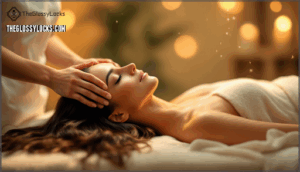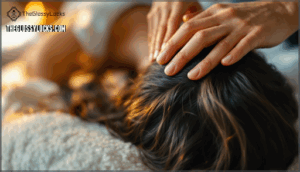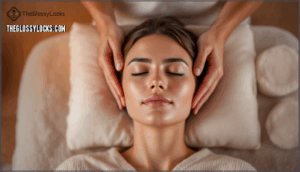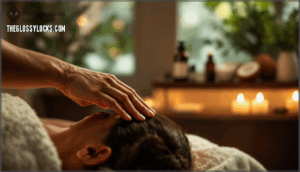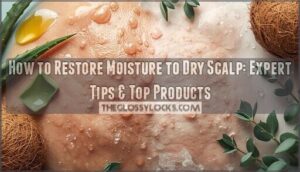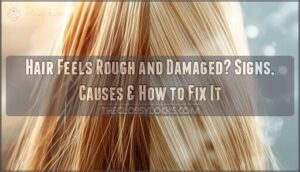This site is supported by our readers. We may earn a commission, at no cost to you, if you purchase through links.
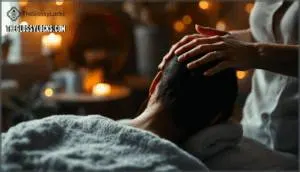
The real question isn’t whether shedding during massage means something’s wrong—it’s whether you’re using the right technique to support your hair’s natural growth cycle instead of working against it.
Table Of Contents
- Key Takeaways
- Is It Normal to Lose Hair During a Scalp Massage?
- Techniques to Prevent Hair Loss During a Scalp Massage
- Benefits of Scalp Massages for Hair Growth
- Recommended Frequency for Scalp Massages
- Traditional Scalp Massage Techniques
- Incorporating Scalp Massages Into Hair Washing Routine
- Enhancing Scalp Massages With Essential Oils
- Frequently Asked Questions (FAQs)
- What happens if you massage your scalp?
- Why does my hair fall after a scalp massage?
- Is a scalp massage the root cause of hair loss?
- Can a massage cause hair loss?
- How does a scalp massage work?
- Should you massage your scalp to remove hair strands?
- Are there any side effects associated with scalp massages?
- Can scalp massages be used to treat hair loss?
- How long should scalp massages last?
- Can scalp massages help with dandruff?
- Conclusion
Key Takeaways
- Hair shedding during scalp massage is normal biology—you’re releasing 50–100 strands already disconnected from follicles as part of the natural growth cycle, not causing new damage.
- Proper massage technique (fingertips only, light pressure, under 10 minutes, with oils) prevents breakage while clinical studies show it increases hair thickness by 8% over 24 weeks through improved blood flow.
- Daily 4–5 minute sessions deliver measurable results, but exceeding 40 minutes daily triggers inflammation and converts your hair growth strategy into a scalp health problem.
- Essential oils like rosemary rival minoxidil’s effectiveness for hair growth when combined with gentle circular massage motions that boost follicle circulation without stressing strands.
Is It Normal to Lose Hair During a Scalp Massage?
How often have you watched hairs spiral down the drain mid-massage and wondered if you’re doing damage? You’re not—this is actually normal. Your scalp sheds 50–100 hairs daily as part of the natural cycle, and massage simply loosens strands already detached from hair follicles. The mechanical action doesn’t cause hair loss; it reveals what’s already left.
In one study tracking scalp health, 68.9% of participants noticed hair shedding during regular massage efforts, yet most saw stabilization or regrowth over time. The key is recognizing that hair fall during scalp massage reflects your body’s rhythm, not a problem you’ve created. Understanding the role of blood circulation benefits can help alleviate concerns about hair loss during massage.
Techniques to Prevent Hair Loss During a Scalp Massage
You don’t have to accept hair loss as the price of relaxation—the right technique makes all the difference. Master these core strategies to protect your strands during scalp stimulation:
- Use your fingertips, never your nails—gentle touch prevents breakage while delivering effective scalp massage
- Apply massage oils or leave-in conditioners first—they reduce friction and strengthen hair during massaging techniques
- Keep pressure light and sessions under 10 minutes—intense scalp stimulation can stress follicles unnecessarily
- Move in slow, circular motions—proper finger techniques distribute natural oils without triggering excessive hair shedding
These hair care fundamentals transform your routine into genuine hair loss prevention.
Benefits of Scalp Massages for Hair Growth
Beyond protecting your strands, scalp massage delivers real, measurable benefits backed by clinical evidence. A 2016 study showed daily massage increased hair thickness from 0.085 mm to 0.092 mm after 24 weeks—proof that follicle stimulation works.
Blood flow can jump 25% during a session, flooding hair follicles with oxygen and nutrients essential for growth. That improved scalp health translates to thicker strands, not just more of them.
Massage therapy also crushes cortisol levels, cutting stress-related hair loss by up to 70% in some studies. The takeaway? Proper massaging techniques don’t just feel good—they trigger real hair regrowth by activating dormant follicles and extending the growth phase.
Scalp massage slashes stress-related hair loss by up to 70% while activating dormant follicles for measurable regrowth
Regular hair growth cycles are vital for maintaining healthy hair and preventing hair loss.
Recommended Frequency for Scalp Massages
Daily massage sessions build momentum for real results. A 2016 study tracked participants who massaged their scalps for just 4 minutes daily—after 24 weeks, hair thickness increased measurably. For serious hair growth goals, aim for twice-daily sessions of 5–10 minutes each, which showed improvement in 69% of participants over 10 months in clinical trials.
Excessive frequency backfires—your scalp needs recovery time between sessions. Push beyond 40 minutes daily, and you’ll trigger inflammation instead of healing, turning your hair fall prevention strategy into a self-inflicted problem.
Here’s what works:
- Minimum commitment: Once weekly keeps scalp health in check with consistent stimulation
- Growth-focused routine: 4–5 times per week maximizes blood flow to follicles without overdoing it
- Oily scalps: Bi-weekly sessions manage sebum and prevent buildup
- Dry or sensitive scalps: Monthly massage preserves natural oils and reduces irritation risk
Traditional Scalp Massage Techniques
Ancient healing traditions understood what modern research now confirms—your scalp holds the blueprint for hair transformation when you know exactly how to access it.
Master circular massage strokes using your fingertips—not nails—to manipulate tissue and stimulate hair follicles without triggering hair fall. Apply light pressure across key pressure points while mapping your scalp in sections, working from hairline to crown.
These massaging techniques boost scalp health by increasing blood flow to dormant follicles, turning your scalp massage routine into a precision tool for reversing damage and reclaiming control over your hair’s destiny.
Incorporating Scalp Massages Into Hair Washing Routine
Transform your weekly shampoo routine into a follicle-awakening ritual by weaving scalp massage directly into your wash day—no extra time required, just smarter technique.
Here’s how to elevate your routine:
- Scalp Preparation: Apply conditioner first to cushion strands and prevent hair fall during manipulation.
- Massage Timing: Work in 5-minute intervals using fingertips—pressure that feels good without causing discomfort.
- Massaging Techniques: Use circular motions across sections, tracking from hairline to crown for complete coverage.
- Hair Type: Adjust pressure based on your strand thickness—finer hair demands gentler management.
- Routine Consistency: Repeat twice weekly to maintain scalp health and enhance blood flow without overstimulation.
This targeted approach transforms passive washing into active hair loss prevention.
Enhancing Scalp Massages With Essential Oils
Essential oils don’t just smell good—they’re the secret weapon that turns a basic scalp massage into a therapeutic hair growth accelerator. Mix carrier oils like coconut or jojoba with peppermint or rosemary essential oils for powerful scalp stimulation that boosts circulation and follicle health.
These aromatherapy benefits aren’t just placeholders—studies show rosemary oil rivals minoxidil for promoting hair growth.
Apply your oil blend using gentle circular motions with fingertips, never nails, to optimize massage enhancement without triggering breakage. This targeted approach transforms routine scalp massages into evidence-based scalp health treatments.
Frequently Asked Questions (FAQs)
What happens if you massage your scalp?
Think back to those old-timey barber shops where a good head rub was the main event—that’s scalp stimulation at work.
When you massage your scalp, you’re boosting blood flow to hair follicles, which can support hair regrowth and improve scalp health over time.
Why does my hair fall after a scalp massage?
Hair falls out during scalp massage because you’re loosening strands already in their resting phase—part of your natural hair growth cycle.
Trapped hairs, buildup, or aggressive massage techniques can also trigger shedding. If your approach causes scalp inflammation or follicle stress, you’ll notice more hair fall than usual.
Is a scalp massage the root cause of hair loss?
No, scalp massage isn’t the root cause of hair loss. It’s usually shedding hair already in the resting phase of the hair growth cycle.
However, aggressive massage techniques can stress hair follicles and cause breakage, while improper methods may trigger scalp inflammation affecting healthy roots.
Can a massage cause hair loss?
No, massage itself won’t trigger Hair Loss—but aggressive Massaging Techniques for Hair can snap fragile strands.
Gentle Massaging protects Hair Follicles while boosting Scalp Health, preventing unnecessary Hair Fall from rough treatment that stresses your scalp’s foundation.
How does a scalp massage work?
When you press and move your fingertips across your scalp, you’re activating nerve endings and boosting blood flow to hair follicles.
This scalp stimulation increases circulation, delivering oxygen and nutrients that support follicle health and can strengthen existing strands through improved scalp circulation.
Should you massage your scalp to remove hair strands?
You can gently massage your scalp to loosen trapped hairs and remove dead strands that are ready to shed.
This type of scalp exfoliation promotes hair follicle health when you use gentle techniques, but don’t force out hair strands.
Are there any side effects associated with scalp massages?
Even when done right, friction and natural shedding can lead to temporary hair fall.
Too much pressure, overly long sessions, or aggressive techniques stress hair follicles and trigger breakage or scalp irritation, especially if there’s existing buildup or trapped hairs underneath.
Can scalp massages be used to treat hair loss?
You can use scalp massage as part of your hair loss treatment strategy. Regular sessions boost blood flow to your follicles, potentially strengthening existing strands and supporting hair regrowth.
However, massage therapy works best alongside other treatment options—don’t rely on scalp stimulation alone if you’re experiencing significant hair fall.
How long should scalp massages last?
Keep your scalp massage sessions under 10 minutes to protect hair follicles from unnecessary stress.
Research shows daily massages lasting just a few minutes can thicken hair over time when you use gentle strokes and light pressure.
Can scalp massages help with dandruff?
Scalp massage offers real dandruff relief by boosting circulation and clearing flaky buildup. This massage benefits your oil balance while promoting scalp exfoliation, helping control the irritation behind a flaky scalp.
Through proper massaging techniques, you can enhance hair care and scalp health, ensuring a healthier and more comfortable scalp.
Conclusion
Mastering massage mechanics means understanding why hair falls out when you massage your scalp—and using that knowledge to your advantage. Those shed strands aren’t casualties of your technique; they’re proof your follicles are cycling through their natural phases.
By applying gentle pressure, using proper oils, and timing your sessions strategically, you transform a simple ritual into a growth-promoting practice. Your scalp doesn’t need saving from massage—it needs the right approach to thrive.
- https://haireveryday.com/prevent-scalp-from-itching-after-hair-coloring/
- https://www.aad.org/public/diseases/hair-loss/causes/18-causes
- https://www.reddit.com/r/longhair/comments/zm29x1/is_it_normal_for_hair_to_shed_when_doing_a_scalp/
- https://pmc.ncbi.nlm.nih.gov/articles/PMC6380978/
- https://perfecthairhealth.com/dermatology-and-therapy/excerpt_suppinfo1.pdf

